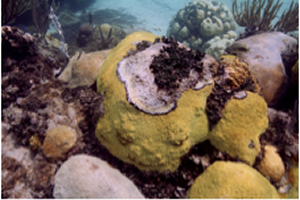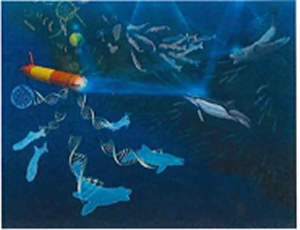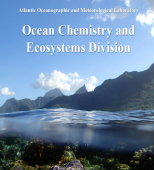"Omics" refers to biological analysis at the molecular level (i.e., DNA, RNA, or proteins). It is used
to identify organisms and their activities (e.g., carbon, oxygen, metals, toxins, and nutrients).
Sequencing techniques allow many types of organisms (viruses to larvae) to be characterized from a single
sample of seawater or sediment. A program at the Atlantic Oceanographic and Meteorological Laboratory (AOML)
will use 'omics to study genes and proteins to better understand how marine organisms and ecosystems remain healthy.
The spring 2016 launch of the 'Omics program at AOML coincided with the promotion of the National Microbiome
Initiative which seeks to better understand communities of microorganisms that are critical to both human
health and the world's ecosystems. 'Omics tools can aid NOAA's environmental intelligence mission by improving
understanding of biological changes occuring at individual, population, and ecosystem scales.
Current projects being conducted by or in conjunction with AOML's Ocean 'Omics are:
Coral 'Omics Experimental Laboratory and Field Sampling to Understand and Combat Environmental Stressors
In September 2016, AOML completed the construction of a new coral 'omics laboratory to conduct controlled experiments
at the University of Miami's new Marine Technology Life Science Seater facility, including custom software to monitor
and precisely manipulate treatment conditions. A hallmark of the aquaria will be the ability to adjust pH measurements
to as low as 0.05 pH units.
Warming oceans and bleaching can increase a coral's susceptibility to disease. At research sites in Florida and the
Caribbean, scientists will sample coral reefs, water, and marine sediments to identify variations that may explain why
some corals are more susceptible or resilient to bleaching or coral diseases than others. With a focus on two species
of rare and endangered corals, scientists are collecting and studying coral tissue to identify the genetic makeup and
diversity of the microbiome, which consists of poorly understood communities of microorganisms living in close association
with corals. The term "holobiant" refers to the coral animal, photosynthetic symbiont, and microbiome (closely associated
prokaryotes). Holobiant 'omics will be studied to understand the mechanics of resilience to improve the success of coral
restoration. Shown below is Black-band disease on a pale coral colony of Montastraea cavernosa in the Florida Keys.
 |
By using next-generation-sequencing of the DNA and RNA associated with these microbiome communities before, during,
and after bleaching or coral disease events, researchers hope to identify the genetic traits of the most resilient
corals and their microbial communities. Experiments will aim to identify communities that are associated with corals
that are resistant to warming waters and disease in order to advise coral restoration efforts across the region.
Autonomous Technology to Support Ecosystem and Fisheries Assessments - 3G-ESP/LRAUV mobile 'Omics
platform
A collaborative project will test the potential of a state-of-the-art autonomous underwater vehicle (AUV) to
conduct marine microbiome analysis. Successful development and transition of genomic analysis using AUV technology
could reduce sample processing time, rising ship time costs, and reliance on tissue sample collection. This work
will test instrumentation from the Monterey Bay Research Institute in partnership with the J. Craig Venter Institute,
NOAA's National Marine Fisheries Service, and the Scripps Institution of Oceanography. In addition to assessing
the microbiome to improve our understanding of food web dynamics, the project will also include field-testing of
a new concept known as environmental DNA (eDNA). This technique detects the genetic signatures of macro-organisms
such as invertebrates or fish by analyzing cells that have been shed into the water column. Understanding the
onnection between the marine microbiome and fisheries will improve our ability to monitor and predict ecosystem
response to environmental change.
 |
‘Omic Technologies to Support Ecosystem Understanding and Fisheries Assessments (NCOG)
In partner ship with NOAA's Ocean and Exploration Research (OER) Program, labs and programs of the National Marine
Fisheries Service (NMFS), the J. Craig Venter Institute (JCVI), and the Scripps Institution of Oceanography (SIO),
AOML is helping enhance an existing ecosystem observation program by adding technology for genetic sampling as part
of the California Cooperative Oceanic Fisheries Investigations (CalCOFI) program. CalCOFI is one of the longest-running
ocean observing programs and seeks to gain a comprehensive understanding of the dynamics of the California Current ecosystem
to foster stewardship, resilience, and sustainable resource management. By introducing these genetic sampling technologies,
scientists hope to improve understanding of the diversity and functions of microbes in the ecosystem, enabling better
prediction of ecosystem response to environmental pressures including climate change. This project is a pilot for
potential broader applications to other regions and across the NOAA research ship fleet.
Meta-'Omic Characterization of Marine Microbiomes: Molecular Observations on Community Structure, Biodiversity,
Ecosystem Functions, and Resilience
This work focuses on the integration of genome-enabled technologies (i.e., 'omics) into NOAA research, assessment and
forecasting efforts, and builds the capacity for NOAA to utilize Community Genomics, Metagenomics, Meta-transcriptomics,
and Molecular Microbial Source Tracking to characterize microbiomes and their ecosystem functions from a variety of marine
habitats, including coastal and oceanic waters, estuaries, seagrass communities, marine sediment communities, marine animals,
marine debris biofilms, and coral reef ecosystems. This work utilizes state-of-the-art Next-Generation-Sequencing of
environmental DNA and RNA combined with metagenomic and transcriptomic bioinformatics analysis to examine marine microbiome
and holobiont community structure, biodiversity, ecosystem function, and response to a wide range of environmental stressors,
including land-based sources of pollution, climate change, sea level rise, ocean acidification, etc.
This work supports a Marine Biodiversity Observing Network (MBON) project led by Dr. Frank Muller-Karger of the University
of South Florida by collecting samples for coral microbiome genetics at key sites along the Florida Keys reef tract. These
sites will coincide with the ongoing MBON sampling of genetic material in the water column.
The NOAA Coral Genomics Observing Network (CGON)
The mechanisms of coral tolerance, health, and adaptation to changing environmental stressors, especially those relating to
adaptation to LBSP, climate change, ocean acidification, sea level rise, and a wide range of various anthropogenic stressors,
is still poorly understood. There are especially significant information gaps about the community level genomic mechanisms
and response to such stressors and the community-level adaptation to these stressor, and in particular the interaction between
the genomics and expression of the coral animals themselves with their associated microbiomes and halobionts. It is extremely
likely that overall tolerance and resilience (or lack thereof) for various combinations of environmental stressors is a community
effect of the inter-active genomic capacity and expression of the coral reef ecosystem including corals and their microbiomes,
and the effect of the biodiversity of these communities to maintain health and function of these ecosystems. This project
utilizes state-of-the-art community environmental nucleic acid sequencing and the metagenomic and transcriptomic bioinformatics
analysis of these environmental community genomic sequences to better characterize the biodiversity, health status, and potential
response and resilience of specific coral communities to current and anticipated environmental stressors. This work focuses on
coral community microbiome characterization of the actual coral cnidarian hosts, their symbionts, microbiomes, and the entire
coral holobiont community, as well as microbiomes of near-coral sediments, and near-coral water column. This coral community
microbiome 'omic analysis serves to supplement the larger Coral 'Omics Initiative at AOML (which also includes genomic characterization
of various genotypes of the coral cnidarian organisms themselves), and also supplements the on-going NOAA International Coral
Observing Network (ICON) and the NOAA Marine Biodiversity Observing Networks (MBON). Collectively, this research provides
critical marine genomic information at a variety of trophic levels to help researchers and managers to better understand the
mechanisms of coral community exposure, tolerance, and adaptation to critical stressors related to land-based sources of pollution
and climate change, and to help inform and direct resource management practices.
|

